A Trip Through History on the Fresque des Lyonnais
La Fresque des Lyonnais, or the Mural of Lyonnais, is a building mural covering the back and side of a bright yellow building on the Saône side of the 1st arrondissement. It is one of the most popular historical monuments for city tourists, depicting some of the many Lyonnais who made the city what it is.
It consists of 24 historic and six contemporary figures, with the modern-day characters painted at street-level to represent them interacting amongst today’s residents and visitors.
The nine-month project took this windowless, characterless wall in the city center and turned it into a veritable destination of Lyonnais culture.
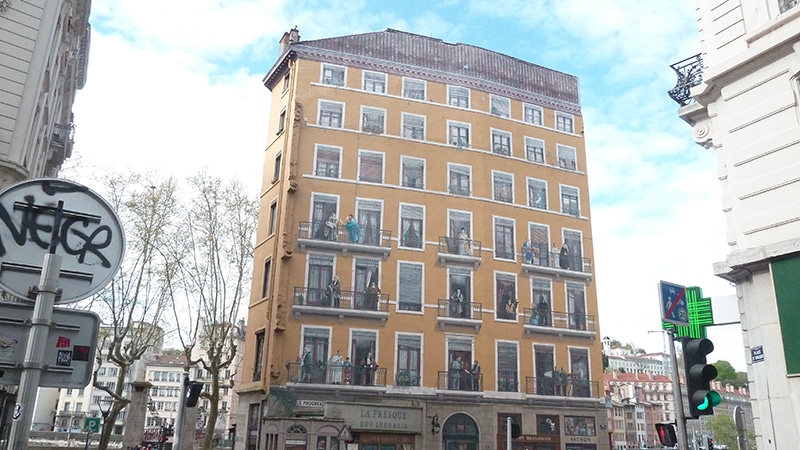
The Fresque des Lyonnais sits on the bank of the Saône, with portraits on both the Rue Martinière and Quai St. Vincent walls. ©Crouzet
La Fresque des Lyonnais is located on the corner of 49 quai St Vincent and 2 rue de la Martinière. The wall measures 800 square meters, with 200 of those square meters on the St. Vincent side and 600 on rue Martinière.
It was painted by the artist cooperative CitéCréation between 1994 to 1995 in an effort to revitalize this central intersection of one of Lyon’s most central and heavily-trafficked districts.
In 1992, CitéCréation had painted a similar mural in Barcelona called La Fresque des Balcons de Barcelone, or the Balconies of Barcelona, that included 30 celebrated painters. Inspired by their work and wishing to do something similar to represent its history, the city of Lyon contracted Cité de la Création to paint the “trompe-l’oeil.”
A list of 250 figures was established, to be cut down to the 30 currently depicted, a mix of women and men from all sectors of advancement and discovery throughout Lyon’s 2000 years of history.
Who’s on the wall?
La Fresque des Lyonnais consists of 30 Lyonnais figures who helped shape the history of Lyon and the world. Their lifespans spread over all 2000 years of Lyon’s history, from ancient Rome to the modern day.
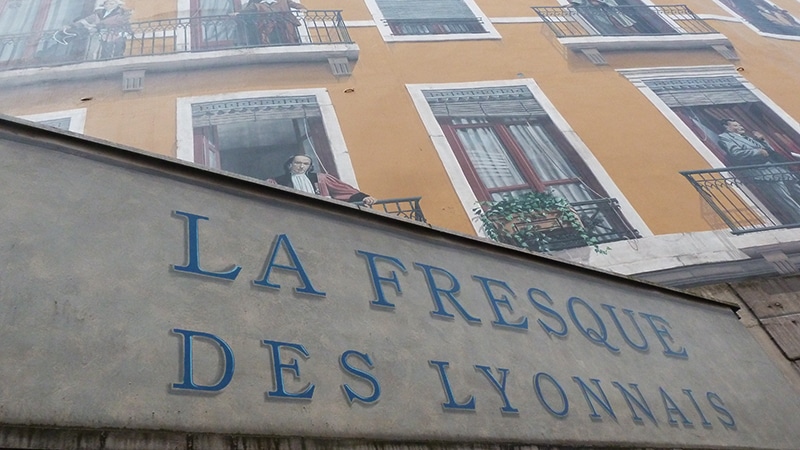
La Fresque des Lyonnais is one of Lyon’s most visited monuments, serving as a crash-course in Lyon history for the city’s many tourists. ©Crouzet
Quai St. Vincent (200m2)
Level 3
Emperor Claudius (c. 10 BCE – 54 AD):
Claudius served as Roman emperor from 41-54. He was born in Lyon, which was at the time called Lugdunum in Gaul. Under his reign the empire was extended to include North Africa and Britain as a province. The effects of Roman civilization can still be seen in Lyon’s roman theaters and aqueduct remains.
Level 2
Pierre Puvis de Chavanne (1824-1898):
Pierre Puvis de Chavanne was a celebrated mural painter who developed a style quite different from other popular artists at the time. He specialized in wall murals like those he painted in the Sorbonne and Paris’s Hôtel de Ville, but also worked as an easel painter and co-founded the Société Nationale des Beaux-Arts. Though he worked mostly in France, he also worked in Boston painting the staircase of the public library.
Jean de Verrazane (late 1400s-1528):
Jean de Verrazane, or in Italian Giovanni de Verrazzano, was an explorer in the service of French king François I. He was one of the first Europeans to widely explore the Atlantic coast of the present-day United States and is said to have discovered the site of present-day New York City.
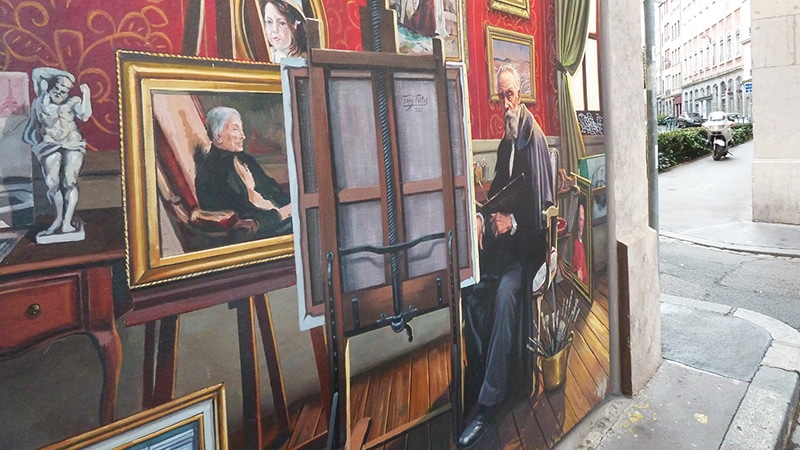
Wall murals are a common sight in Lyon, and some others can be found just around the Fresque des Lyonnais.
Level 1
Joseph-Marie Jacquard (1752-1834):
Joseph-Marie Jacquard is famous for his invention of the Jacquard loom, which automated the silk weaving process and revolutionized the production of the Lyon canuts. The loom caused widespread violence among the silk workers because it made silk-weaving much more efficient and therefore reduced jobs. But the machine was eventually accepted across the world and Jacquard was awarded the Cross of the Legion of Honour for his work.
Philippe de Lasalle (1723-1804):
Philippe de Lasalle was an artist celebrated for his ornate silk designs. His work was especially popular during the 1770s, when he received permission to create mixed fabrics, something that was normally forbidden. In this way he managed to appeal to a somewhat less wealthy clientele, using mixtures of silk, cotton, and linen to create his works. His most important works can be seen at the Musée des Tissus in Lyon.
Street-Level
Bertrand Tavernier (born April 25, 1941):
Bertrand Tavernier is a director and screenwriter. His career stretches from 1960 to the present day with films like L’Horloger de Saint-Paul, Le Mort en direct, Une dimanche à la campagne, La princesse de Montpensier and many others. He won a British Academy of Film and Television Arts Award (BAFTA) for Life and Nothing But in 1990 and a Golden Bear at the Berlin International Film Festival in 1995 for L’Appât.
Rue Martinière Side (600m2)
Level 4
St-Irénée (c. 125-202):
St-Irénée, or St. Irenaeus, was a bishop of Lyon during the late 2nd century. He is buried in the crypt at the Église Saint-Irénée at Saint Just in Lyon.
Ste-Blandine (c. 160-177):
Sainte Blandine is the patron saint of Lyon. Originally a roman slave, she joined the Christian community and was later martyred during the persecutions that also killed Bishop St. Pothius, St. Irénée’s predecessor. She is one of 47 Christians who were martyred during that summer.
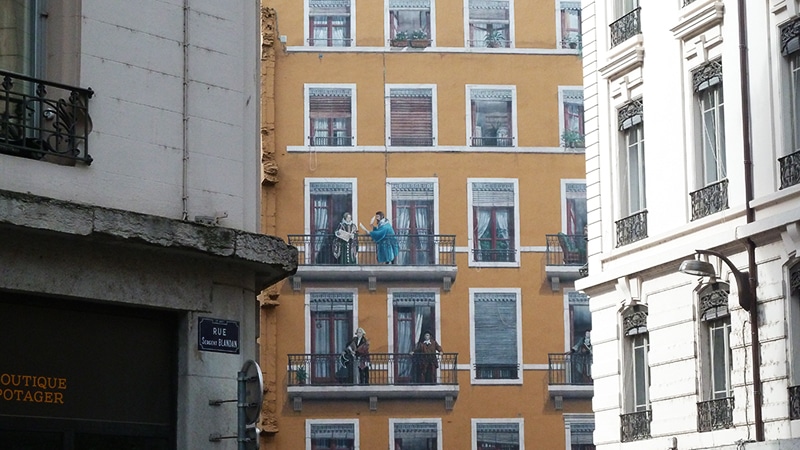
The Rue Martinière wall makes up 600 of the 800 total square meters of painted mural on the Fresque. ©Crouzet
Level 3
Louise Labé (1516-1566):
Louise Labé was a Lyonnaise poet of the Renaissance. She is nicknamed La Belle Cordière, or the beautiful ropemaker, because she was the daughter of a wealthy ropemaker and later married one. She encouraged women to write and her poetry did not shy away from taboo subjects such as passion and female desire.
Maurice Scève (1500-1560):
Maurice Scève was another Renaissance poet focused on the idea of spiritual love. His biggest work is a collection of 449 10-line poems and one 8-line one entitled Délie, which could be an anagram for the word “l’idée” or idea.
Juliette Récamier (1777-1849):
Juliette Récamier is a symbol of the famous “salons” of the French Restoration. Salons flourished in France in the 17th, 18th, and 19th centuries, as small gatherings often held by women in bedrooms or private drawing rooms where attendees exchanged ideas on politics and literature. Salons were one of the first places where women were put at the head of a discussion on intellectual life. Juliette Récamier’s salon was very popular, and attracted leading literary and political Parisians to its midst.
Claude Bourgelat (1712-1779):
Claude Bourgelat was the founder of the first veterinary school in the world, located here in Lyon. An expert in horse management, Bourgelat soon became the foremost authority on veterinary science in the field of agriculture and elsewhere. He later established a second school just outside of Paris, and set the world on a path to the evolution of the veterinary field.
Pauline Jaricot (1799-1862):
Pauline Jaricot, named “venerable” in 1963 by Pope John XXII, was a prominent Christian missionary. She founded the Living Rosary Association and is entombed in the Église Saint Nizier in the second arrondissement of Lyon.
Claudine Thévenet (1775-1837):
Claudine Thévenet was the founder of the Congregation of the Religious of Jesus and Mary, an organization dedicated to the education and service of youth and children that still exists today. The organization was founded at Croix Rousse in Lyon in 1818 and is now international. Claudine Thévenet was declared blessed in 1981 and canonized in 1993.

The Fresque is comprised of 30 historic figures, with contemporary individuals pictured on street-level interacting with the Lyonnais of today. ©Crouzet
Level 2
Général Major Martin (1735-1800):
Major General Claude Martin was a geographer, engineer, philanthropist, and officer in the English East India Company’s army. A Lyon native, he posthumously founded the Martinière schools in India and Lyon in 1836 as described in his will.
Jean-Baptiste Say (1767-1832):
Jean-Baptiste Say was an economist and businessman who argued for competition and free trade. He is best known for Say’s Law, an economic law of markets that says that supply can create its own demand.
André-Marie Ampère (1775-1836):
André-Marie Ampère is a physicist most famous for founding the field of electromagnetism. He was a gifted inventor and created the galvanometer, used to detect small electric currents. He is one of the 72 people honored with his name inscribed on the Eiffel Tower, and the SI unit of electric current, ampere or amp, is named after him.
Laurent Mourguet & Guignol (1769-1844):
Laurent Mourguet is a puppeteer and creator of Lyon’s very own Guignol, pictured on La Fresque alongside Mourguet. Guignol is one of Lyon’s most important symbols, representing the canut silk workers. His puppet shows are performed all over France, but notably La Maison de Guignol in Lyon (2 Montée du Gourguillon, Lyon 5). While Guignol’s performances are often seen as children’s shows, hints of his original sharp wit and social satire can still be found in today’s productions.
Le Petit Prince and Antoine de St-Exupéry (1900-1944):
Antoine de St-Exupéry was an aviator, writer, and philosopher. He began flying during his military service, and these flights served as the inspiration for his later literary works, including his most famous publication, The Little Prince or Le Petit Prince, pictured alongside St-Exupéry on the wall. St-Exupéry is also the author of Wind, Sand and Stars, which won the 1939 Nonfiction U.S. National Book Award and the 1939 Grand Prix du Roman de l’Académie Française. The Little Prince is one of the best-selling books in the world and is available in 260 different languages.

St-Exupéry is pictured here with his Petit Prince, on Level 2 of the Rue Martinière wall. ©Crouzet
Level 1
Antoine de Jussieu (1686-1758):
Antoine de Jussieu was a botanist most celebrated for his classification of flowering plants. He served as a professor of botany in the Jardin des Plantes in Paris for over 50 years. His classification was in keeping with the binomial nomenclature system, allowing much of his work to be widely applicable even today.
Marcel Mérieux (1870-1937):
Marcel Mérieux was a biochemist and entrepreneur who created the Institut Mérieux, today a leading industrial biology company. He was one of the first students of the Ecole de Chimie Industrielle de Lyon, now known as CPE Lyon. He is pictured with his grandson, Doctor Jean Mérieux.
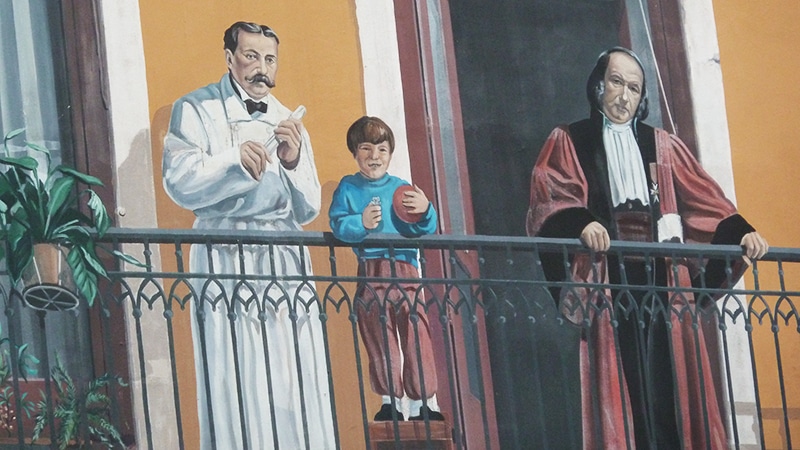
Marcel Mérieux, his grandson, and Claude Bernard are depicted on Rue Martinière Level 1. ©Crouzet
Claude Bernard (1813-1878):
Claude Bernard was a physiologist who championed the use of the scientific method and blind tests in his experiments. He is particularly well known for his work on the functions of the pancreas and the liver, and his contributions to the scientific community’s understanding of homeostasis. He is considered the founder of modern-day physiology.
Edouard Herriot (1872-1957):
Edouard Herriot served as the mayor of Lyon for over 50 years and head of its government from 1924-1925. His long regime was interrupted only from 1940-45, when he opposed the Vichy regime and was therefore exiled to Germany. He was elected to the prestigious Académie française in 1946.

Edouard Herriot is one of Lyon’s most famous figures, pictured here on Rue Martinière.
Tony Garnier (1869-1948):
The namesake of the Halle Tony Garnier in the 7th arrrondissement, Tony Garnier was an architect and city planner. He is responsible not only for the hall, but the Quartier des Etats-Unis in the 8th arrondissement and the Stade de Gerland. He studied at the Martinière and was one of the leaders of 20th century French architecture.
Auguste and Louis Lumière (1862-1954 and 1864-1948):
The Lumière brothers were the inventors of the first motion-picture camera, the cinematograph, and cinematography along with it. Also students of the Martinière, the brothers were gifted in the technical field. Their legacy lives on in the Institut Lumière in the 8th arrondissement of Lyon.

The Lumière brothers can be seen on Rue Martinière Level 1, and their work in the Institut Lumière in Lyon 8. ©Crouzet
Street-Level
Bernard Pivot (born May 5, 1935):
Bernard Pivot is a journalist and television host. He worked for the Figaro Littéraire for over 10 years until the publication closed, and later created the television show Apostrophes, an hour-long primetime talk show focused on authors and books. It ran for 15 years and was one of the most popular shows on French television.
L’abbé Pierre (1912-2007):
Abbé Pierre was a Catholic priest who founded Emmaus, a community organization that works to end poverty and exclusion around the world. He was also an extremely active member of the French resistance during World War II.

L’abbé Pierre stands next to Bernard Lacombe at street-level on Rue Martinière. ©Crouzet
Bernard Lacombe (born August 15, 1952):
Bernard Lacombe is a football player considered one of the best forward players in Ligue 1 French football, racking up 255 goals between 1970 and the end of his playing career in 1987. He went on to act as manager for his home team, the Olympique Lyonnais, alongside president Jean-Michel Aulas and still holds a large influence within the team.
Paul Bocuse (1926-2018):
Paul Bocuse was an internationally-recognized restaurateur. Holder of three Michelin stars for fifty years, Bocuse is known around the world for his empire of gastronomy, one that launched Lyon onto the international stage. He is a large part of the reason Lyon is known as the world’s capital of gastronomy.
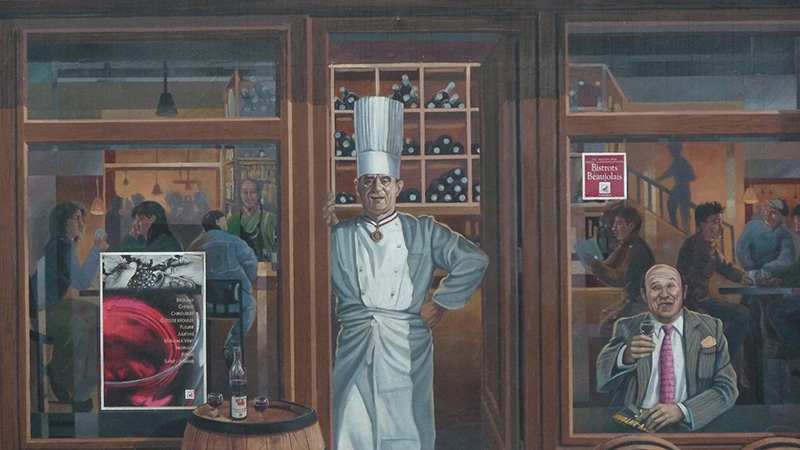
Paul Bocuse’s portrait is at street-level, alongside other contemporary Lyonnais. ©Crouzet
Frédéric Dard (1921-2000):
Frédéric Dard was a celebrated crime novel writer. He is most well-known for his San-Antonio series, written under a pseudonym of the same name. San-Antonio was produced from 1949-2001 and followed the adventures of a police detective, selling over 200 million copies during its run. Dard was also a student of the famous Martinière school.
Tips and Tricks
Tip 1: Try to get to the wall in the morning on a sunny day. The light hits just right around 10 or 11 a.m., before dipping behind the building in the afternoon.
Tip 2: The area around the Fresque is full of other smaller wall paintings. Wander around and see what you can find!
